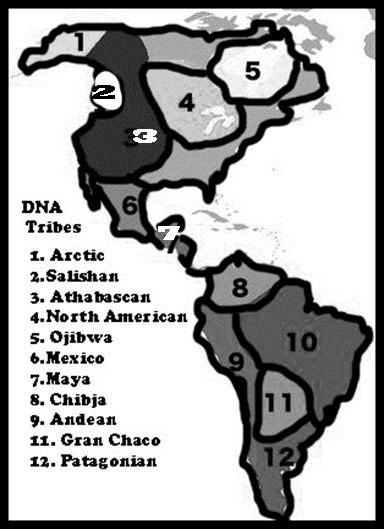A Rough Outline of Tribal Divisions (17 December 2015, 5 Tevet, 5776)

The Na-Dene Peoples
The Na-Dene peoples may have been late-comers expelled from Northern China and Mongolia as explained by Ethel G. Stewart (1991). Na-Dene Languages are also known as Athabascan. Linguists conventionally divide the Athabaskan family into three groups, based on geographic distribution: Northern Athabaskan; Pacific Coast Athabaskan; and Southern Athabaskan or Apachean. The Southern group includes Navajo and the six Apache languages.
The Tlingit were located in southern Alaska in the United States and British Columbia and the Yukon in Canada. The Tlingit were a seafaring people, skilled fishers, traders and hunters-gatherers, The four social classes of the Tlingit tribe consisted of royalty, the nobles, the commoners, and the slaves. Children born to slaves were also considered as slaves. They spoke an Alaskan language distantly related to the Athabaskan languages. In 1867 USA acquired Alaska from Russia. and the Tinglit passed to American authority.
Arctic and Sub-Arctic Indians
Other tribes in the north encompassed the Inuit (Eskimo) and the Aleut tribes of present day Alaska, Canada and Greenland. The Aleuts are considered to be closely related to the Inuit though their culture is different. Eskimoes (known as Yupiks) are also present in Russia, and in Greenland.
Canadian and Great Plains Indians
Algonquian languages were spoken by Blackfoot, Cheyenne, Cree, Fox, Menominee, Potawatomi, and Shawnee. Algonquians dominated Quebec. So too a similar tongue was spoken by Chippewa (Ojibway) and Ottawa Indians who were allied against the Iroquis and the Sioux.
The Iroquis in Canada and the USA also known as "Six Nations", comprising the Mohawk, Onondaga, Oneida, Cayuga, Seneca, and Tuscarora nations. The Iroquois absorbed many other peoples into their cultures as a result of warfare, adoption of captives, and by offering shelter to displaced nations. The historic Erie, Susquehannock, Huron (Wendat) and Wyandot, all independent peoples, also spoke Iroquoian languages. In later white civilization Iroquois tribesman came to dominate the iron building trade in New York for decades. Their lack of fear of heights made them suitable to the task.
The Cherokee Nation
The Cherokees spoke an Iroqous language but dwelt alongside other tribes who did not. The Cherokees were the most populous of Amerindian Tribes. The Cherokees occupied a common homeland in the southern Appalachian Mountains and in northern Georgia. The famous Indian mounds are attributed to the Cherokees. During the winter of 1838-39 the Cherokees were forced to evacuate their territory and move to Oklahoma. More than 4,000 Cherokees died on what is known as the "Trail of Tears." The Cherokee Nation accepted both whites and blacks into their ranks. They also intermixed with the whites. Most long term inhabitants of Oklahoma and its neighborhood have some Amerindian ancestry despite often looking very Caucasian.
The Sioux Indians
The Sioux Indians were also known as the Lakota or Dakota. Sioux people were farmers, hunters, and gatherers. The Sioux leader Chief Sitting Bull is famous for having defeated US General Custer. After the acquisition of horses in the 1500s buffalo meat became the staple diet. The horse was unknown in the Americans until introduced by Europeans. Like the Sioux numerous other Tribes of diverse origins living on the Great Plains became horse riding nomads and followed the buffalo. Familiar names include Blackfoot, Comanche, Cheyenne, Crow, Mandan, and Pawnee. White settlers also hunted buffalo and had brought them to near extinction by 1884.
The Apache
The Apache and related tribes in the Southwestern United States and Northern Mexico speak Southern Athabaskan languages. They included the Navajo. The Navajos were employed by US forces in World War-2 for coding and decoding secret messages. The Navajo had been the traditional enemy of the Pueblo peoples.

The Pueblo Indians and the Anasazi
The Pueblo peoples were in the Southwestern USA. They lived in towns constructed of adobe, stone and other local materials. These buildings were constructed as complex apartments with numerous rooms. They were often built in strategic defensive positions. The style of building is studied today. Lessons learnt from it are applied in modern architecture. The Pueblo peoples speak languages from several different groups and are also divided culturally by their kinship systems and agricultural practices. All cultivated varieties of maize. The Pueblo were preceded by a group referred to as the Anasazi whose civilization lasted from ca. 500 CE to 1300 CE. The Anasazi had a developed civilization showing astronomical knowledge, and impressive building skills.
The "Five 'Civilized' Tribes"
The "Five 'Civilized' Tribes" were the Cherokee, Chickasaw, Choctaw, Creek (Muscogee), and Seminole. They dwelt in the southeast of the USA. They were referred to as 'civilized' due to practices considered the marks of civilization such as the adoption of Christianity, centralized government, literacy, market participation, written constitutions, intermarriage with white Americans, and plantation slavery practices.
Seminole
The Seminole speak a Creek language. They are now found in Florida, Oklahoma, and Kansas. The Seminole nation came into existence in the 1700s. It was composed of renegade and outcast mostly Creek Indians. The Seminole held some Black people as slaves. Other blacks however were allowed to dwell among them in their own independent communities in return for tribute and military service.
